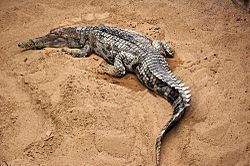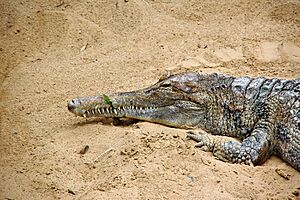False gharial facts for kids
Quick facts for kids Tomistoma |
|
|---|---|
 |
|
| Conservation status | |
| Scientific classification | |
| Kingdom: | |
| Phylum: | |
| Class: | |
| Order: | |
| Family: | |
| Genus: |
Tomistoma
Müller, 1846
|
| Binomial name | |
| Tomistoma schlegelii (Müller, 1838)
|
|
 |
|
| Range of false gharial | |
The false gharial (also called the Malayan gharial) is a cool freshwater reptile. Its scientific name is Tomistoma schlegelii. It looks a lot like a crocodile, but it has a super long and thin nose, just like the gharial. That's how it got its name!
For a long time, scientists thought the false gharial was part of the crocodile family. But newer studies, which looked at how their bodies fight off sickness (called immunological studies), showed something different. These studies found that the false gharial is actually more closely related to the gharial. So now, it's placed in the same family as the gharial, called Gavialidae.
Contents
Where False Gharials Live
False gharials live in different parts of Southeast Asia. You can find them in six river systems in Sumatra and Malaysia. They also live in places like Borneo, Java, Vietnam, and possibly Sulawesi.
Sadly, they haven't been seen in Thailand since 1970. We also know from old fossils found in southern China that they used to live there a long time ago.
Life Cycle and Reproduction
Like all other crocodilians, false gharials lay eggs. They are known as "mound nesters." This means the mother builds a special nest out of dry leaves or peat (a type of soil).
Female false gharials usually grow to be about 2 to 3 meters long before they are old enough to have babies. Once they are ready, they will lay a clutch of 30 to 60 eggs in their mound nest. After the eggs are laid and the nest is built, the mother leaves.
Unlike many other crocodilians, false gharial babies don't get any help from their parents. They are on their own from the moment they hatch. This means they are at risk from predators like wild boars, mongooses, big cats (such as tigers and leopards), civets, and wild dogs. The eggs hatch after about 90 days, and the young gharials have to take care of themselves right away.
Protecting False Gharials
The false gharial is in danger of disappearing in most of the places it lives. One big problem is that their homes are being destroyed. The swamplands where they live are being drained, and the surrounding rainforests are being cut down. This takes away their habitat (the natural place where an animal lives).
People also hunt false gharials for their skin and meat. Their eggs are sometimes collected for people to eat. However, the governments of Malaysia and Indonesia are working hard to help these animals. They are taking positive steps to protect the false gharial and prevent it from becoming extinct in the wild.
- Database entry includes a brief justification of why this species is endangered and the criteria used
Images for kids
-
Skull of a false gharial at the Zoological Museum of the Zoological Institute of the Russian Academy of Sciences, St. Petersburg
See also
 In Spanish: Gavial malayo para niños
In Spanish: Gavial malayo para niños





